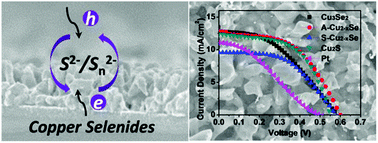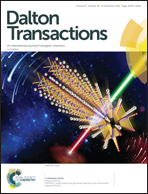Copper selenide (Cu3Se2 and Cu2−xSe) thin films: electrochemical deposition and electrocatalytic application in quantum dot-sensitized solar cells†
Abstract
In this work, high crystallinity copper selenide thin films directly deposited onto conducting substrates were obtained through a potentiostatic electrodeposition approach. The as-deposited copper selenides involve annealing induced phase transformation from tetragonal Cu3Se2 to cubic Cu2−xSe. The annealing also leads to a remarkable morphology change from dendritic nanosheets to connected networks and separated particle shapes for the annealed (A-Cu2−xSe) and selenized (S-Cu2−xSe) samples, respectively. The copper selenide thin films were demonstrated to serve as efficient counter electrodes (CEs) in quantum dot-sensitized solar cells (QDSCs) for electrocatalyzing polysulfide electrolyte regeneration. The CdS/CdSe QDSCs constructed with copper selenide CEs deliver considerable power conversion efficiencies (PCEs), especially an optimal value of 3.89% for the A-Cu2−xSe CE-based device. The enhanced photovoltaic performance benefits from the connected network microstructure of A-Cu2−xSe films which afford a large number of reaction sites and efficient charge transport pathways. The Tafel polarization characterization further indicates that, in contrast to the commonly used Cu2S and Pt CEs, the non-stoichiometric Cu2−xSe CE exhibits better electrochemical catalytic activity. This work highlights the great potential of electrodeposition for fabricating promising copper selenide CEs for high performance QDSCs.



 Please wait while we load your content...
Please wait while we load your content...